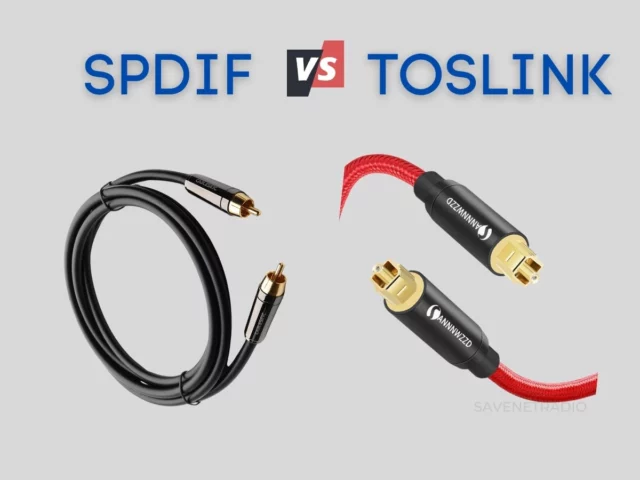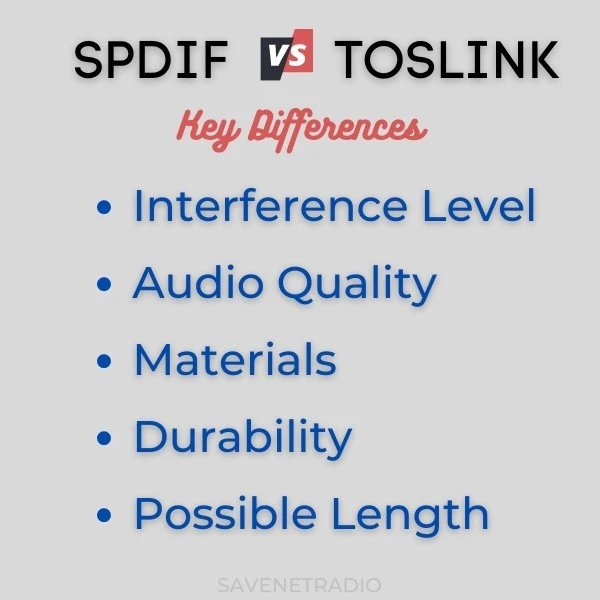
In the world of connection cables, the SPDIF and TOSLINK varieties are two of the most popular. These cables exist everywhere, yet it may be tricky to understand the differences between them.
The differences between SPDIF vs. TOSLINK cables include their physical appearance, application, and sound quality. Despite their functional similarities, these are noticeable differences between the SPDIF cable and the TOSLINK.
To understand the differences between the SPDIF cables and TOSLINK cables, you will need a more comprehensive understanding of what makes each cable work and what they do. Keep reading to learn about the differences between the SPDIF and TOSLINK cables.
Differences b/w SPDIF Cables and TOSLINK Cables
One of the most crucial differences between SPDIF and TOSLINK lies in what they are. The SPDIF cable is the new connector. It has either an RCA connector or a TOSLINK connector.
Thanks to these differences, SPDIF and TOSLINK operate in different manners. A SPDIF can be a TOSLINK cable, but not the other way around. This divergence is crucial to distinguish.

Topics Covered - Index
1. Applications of SPDIF & TOSLINK Cables
Both the SPDIF cable and the TOSLINK cable are made for transferring audio. However, there are a few differences in how the audio carries and what each of these cords does for those who invest in them.
These differences might seem small, but they noticeably affect the audio for each cable. This is not to suggest that one cable is better than the other, but that the SPDIF and TOSLINK provide their own unique audio experience.
Typical Use of a SPDIF Cable
The SPDIF cord resides in the world of entertainment. It uses quite a bit of energy, but the transfers that it makes are fast and reliable. This quick turnover suits movies and other forms of visual wonder well. The SPDIF cord is also used for:
- Dolby Surround Sound
- Home theaters
Its high-quality output means that the SPDIF cable operates best for situations in which quality sounds are needed for overall impact. A SPDIF cable functions well with most forms of entertainment and items that project sound across a broader area.
Typical Use of a TOSLINK Cable
TOSLINK, on the other hand, is used for different purposes. It also delivers quality audio but works best for smaller systems. Often, the TOSLINK cable is used to carry audio for:
- Editing systems
- Personal Consoles
The TOSLINK uses a lot less energy than the SPDIF. Thus, it can work best for personal devices. TOSLINK cables are often used for purposes other than entertainment.
2. Materials That Make up Each Cable
Both the SPDIF and TOSLINK cables are made of different materials. These are distinct reasons why the audio output is utilized for differing purposes.
The TOSLINK cable is made up of:
- Glass
- Plastic
These materials allow for an efficient transfer of data through light pulses. This unique method works well for audio output.
The SPDIF cable, on the other hand, is made of:
- Copper cable
- Insulative layer
- Conductive shielding
These materials permit the SPDIF cable to be more durable. The SPDIF does not look as appealing aesthetically, but it will last longer and stand up to outside forces better than the TOSLINK cable.
3. The Durability of Each Cable
Durability is a crucial factor in a cable if there is a need to bend them to reach either connection point. You do not want something that is going to shatter the moment that you kink it.
The SPDIF and TOSLINK cables both have their limitations in different ways. These can affect their usage and how long they last.
The Durability of a TOSLINK Cable
The TOSLINK cable is not able to handle very long distances. Though it is excellent at transferring sound, this does not translate to distance. This lack of ability is since the TOSLINK cable:
- It becomes damaged when bent
- Reduces sound quality when the length is extended
- It is made of more fragile material
It is best not to bend these cables. If they need to be longer, repeaters can avoid damaging the product past usability.
The Durability of a SPDIF Cable
The SPDIF cable is a lot more durable than the TOSLINK. They can bend without being damaged and can last years longer than the other. This is thanks to:
- Their thickness
- The material that they are made of
However, the downfall of SPDIF cables is their susceptibility to interference and electrical surges. The interference issue is the only item that can significantly reduce the lifespan of a SPDIF cable.
4. Possible Length of Each Cable
In terms of length, the SPDIF cable can outstretch the TOSLINK. Though the TOSLINK can be increased through extenders, its fragile nature makes this task difficult to do. The SPDIF cable can extend to further lengths while still providing quality sound.
The longer the cable gets, the less high-quality the sound becomes with most items. This applies to the SPDIF cable. The shorter, the better. However, it is good to note the possibilities of each cable.
5. Levels of Interference
Although both of these cables provide quality connections, only one of them is prone to interference. This con is vital to consider before investing.
Interference can shorten the lifespan of a cable. It can also interfere with the audio quality produced through the SPDIF or TOSLINK cable.
Interference and the SPDIF Cable
OF THE TWO, the SPDIF cable is the most prone to interference. This is for a variety of reasons. Some of these include the fact that the SPDIF cable:
- It uses an electromagnetic current, leaving them vulnerable in the case of a short circuit
- Can be impacted by electrical problems affecting your home
The SPDIF cable can experience interference or even short out thanks to these issues. This can be unfortunate for your electronic devices and the quality of noise.
Interference and the TOSLINK Cable
On the other hand, the TOSLINK cable is largely immune to these interference issues. Since they possess unique connectors and utilize light pulses to transfer data, they can avoid these issues as they process audio.
In terms of interference, the TOSLINK is the way to go. However, the SPDIF typically does not experience a drastic amount of interference if properly managed.
6. Quality of Output Audio
THANKS TO THE INTERFERENCE, the SPDIF is less reliable in the audio output. The TOSLINK cable can produce audio without fear of interruption. It should be crystal clear every time it is put into use.
If there are no issues with the SPDIF cable, the audio on both is of similar quality. The audio of the SPDIF cable and the TOSLINK cable is:
- Clear
- Strong against demanding devices
- Easy to access
Quality is not in question with either of these products. Interference is the only possibility in the SPDIF that could affect this factor, but that does not happen often. Either product will provide great audio. The difference mostly comes down to what device you are hooking the cables up to and what setting you are using them.
Conclusion
Both the TOSLINK and SPDIF cables transfer audio in the world of sound. While they often are used for the same purposes, they have many significant differences. These can vary from the application of the product to the levels of interference each one experiences.
Despite these contrasting purposes, both cables do their job quickly and efficiently. Whichever cable you decide to use, the audio experience will be enjoyable and high-quality except in rare instances.
Sources: